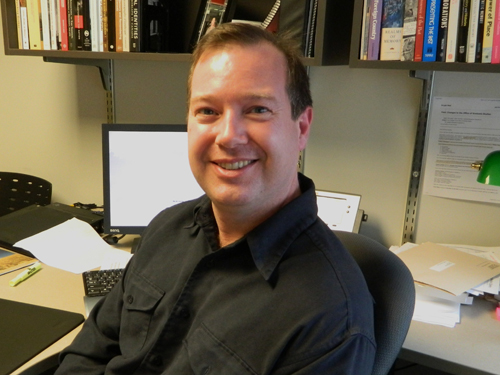
The word “amateur” – meaning someone who engages in a pursuit for love, not money – often has negative connotations. A professional gets the job done right; an amateur may just be a bumbler. But history professor Alan Gordon is more positive about amateur historians than you might expect from someone who has made history his profession. “They play an important role in getting historical issues discussed and debated,” he says.
But there are also potential problems for the amateur historian, and Gordon cited the case of Port Royal in Nova Scotia as one example during a recent presentation at the University of Windsor. His research on Port Royal is part of a broader look at living history museums across Canada that he is developing into a book.
“In the 1930s, a group of history buffs in Nova Scotia persuaded the government to put money into rebuilding Port Royal,” Gordon explains. Port Royal was a short-lived settlement founded by the explorer Samuel de Champlain in the early 1600s. All traces of the settlement had long been lost, but maps and drawings by Champlain gave some hints about the location and style. The group soon identified what they were quite certain was the original location of Champlain’s settlement.
Among the most enthusiastic of these amateur historians, says Gordon, was American Harriet Taber Richardson, who had been spending her summers in Nova Scotia. She worked with the local historical society and helped to persuade a landscape architect from Harvard to help. With her assistance, funds were raised in the U.S. as well as in Canada. “Americans in the northeast part of the country see Champlain as an important historical figure in their country,” Gordon points out.
But putting together a design and precise location for the revived Port Royal turned out to be harder than expected. “The drawings by Champlain that they were using were pretty vague,” says Gordon. “And of course, the landscape had changed in 300 years.” As more experts came on board, there was increasing skepticism about the local claims of the precise location.
“At that point, the Parks Department decided that it didn’t have to be exactly right, as long as it was possibly right.” Port Royal was built in the late 1930s and continues to be a popular tourist attraction today. But there are some jarring elements to the history professor’s eye.
“For example,” says Gordon, “there is a well in the centre of the courtyard that is supposed to be Champlain’s well. The experts say it’s probably not, because there is a large stone blocking the spot where it should have been when you dig down a short way. So they just moved it a few feet over. The amateurs set out to find what they expected to find, and kept finding evidence to suggest they were wrong. So they had to make adjustments.”
Today, he adds, Port Royal is promoted as a representation of the past, rather than an accurate reproduction of the original settlement.
Amateur historians can also put an interpretation on history that is more straightforward than the reality. Gordon mentions historical re-enactors who play out battles from the War of 1812 and other events. “It’s a nationalistic and militaristic version of history,” he points out.
Another example is the use of the barter system at Black Creek Pioneer Village. “The curator latched onto this idea, but it was really more complex than it is portrayed there. People didn’t just trade chickens for farm tools. More often they would get store credits from the general store based on what they brought in.”
On the other hand, Gordon is upfront about “the debt professional historians owe to amateurs. They are the ones who often amassed the documents and evidence for us to use,” he says. In the early 1800s, for example, Georges-Barthelemi Faribault, a Quebec lawyer and legislative assembly clerk, set out to collect and catalogue documents relating to the history of North America and, in particular, Canada. He even hired young doctors and lawyers to travel to England and France to find and make copies of additional documents. Sadly, many of the documents he had so carefully collected were destroyed in 1849, during a riot in Montreal, which led to the burning of the parliament buildings. Faribault rebuilt most of the collection but the parliamentary library was again destroyed by fire in 1854. Upon his death, many of the remaining documents in Faribault’s possession were left to Laval University.
Today, Gordon adds, “Amateur historians keep up interest in these topics. The books academics write don’t sell as many copies as the great stories told by writers like Pierre Berton. We get bogged down with footnotes.” While amateurs may sometimes miss the context because they are more focused on the details of history, professionals sometimes focus too much on context and forget the important details.
“It’s not really that one is better than the other, they are just different ways of focusing on the past,” says Gordon.